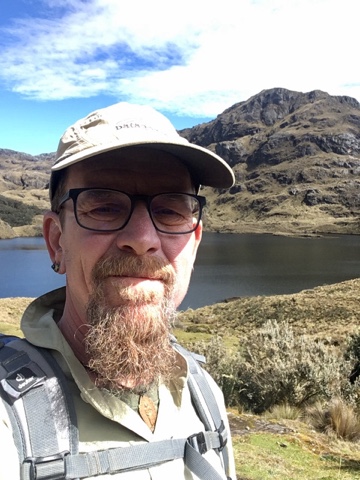High in the Caja, the western spine of the Andes Mountains
Cuenca, Ecuador, sits in a valley between the eastern and western spines of the Andes. The city is at an elevation of about 8,300 feet above sea-level. Traveling over the top of the eastern spine of the Andes will drop one into Amazonia. Travel to the west, over the Cajas, and one will begin the very steep descent to the hot, wet, fertile fields that surround Guayaquil. Sprawling across the very top of the Cajas is the Parque Nacional Cajas. Steep Andean peaks climb towards the sky from the trailhead, which is perched at an elevation of over 13,000 feet above sea-level. The Parque is home to the Andean Condor, Coati, and a host of strange and rugged plants. There are other creatures as well, strange creatures. Giant earthworms burrow in the soils, worms that reach a meter in length and an inch in girth. And, supposedly, giant frogs.
With this wonderland close at hand, what could any hardy traveler do but set out for a hiking excursion? Fueled with a hearty gringo brekkie, we drove the forty-five minute climb up to the Parque. There is no entry fee, but all hikers have to register. The Rangers dislike packing out unknown dead gringos. Our goal was a strenuous hike, breathing the thin air at high altitude. Our hope was to get a glimpse, perhaps, of the mysterious Giant Frog.
Giant Frogs!! From an image that appeared in a local news article.
Villagers claim that the giant frogs live in the valleys of the Caja. Big enough to gulp down a small dog, the gargantuan amphibians are a matter of some dispute. But what the hell, why not go look for a frog that could swallow Fluffy the Poodle? Big Foot, the Yeti, Crop Circles, Giant Frogs, any of these could serve as a good excuse for a romp. Fully-packed for the incredibly changeable weather, we set out along a narrow path that led through the vast open alpine landscape. The Caja has hundreds of lakes, some no bigger than a puddle. Most of the vegetation consists of ground-hugging sedges, hardy clump grasses, and rock-clinging lichen. Clouds sweep across the sky, bringing chill shadows. The shadows and sunlight compete to dapple the craggy mountains with ever-changing patterns of light and darkness. The air is thin, very thin. Climbing a steep trail is an effort.
High in the Andes
Living close to the ground
There is very little here that is tall save the rocky peaks. To survive the harsh conditions of this environment, plants hug the ground. There are tiny sedges everywhere, putting out small flowers that seem to be afraid to show themselves. The flora amongst the rocks is best viewed by getting down on all fours and crawling around. It is also, I suppose, a good way to find a giant frog. If you happened to be looking for one.
Life clinging to the rocks
Puffing like good little locomotives, our merry band of four rounded the first lake. The sun baked down on us as we gulped at the rarified air. Over one rise, then another, we climbed slowly. Ahead of us was one of the few pockets of larger vegetation, the paper-tree forest. Tucked into a cleft at the base of a sharp peak, the entire forest covered only few acres. The trail plunged into the thin, twisted trees. Surely, if there we were going to encounter mysterious creatures, this would be the place.
Wait, what is that disembodied human hand doing there???
The trail through the paper-trees
Alas, I cannot report sighting any giant amphibians. There was, however, a slippery descent through the munchkin forest and into the next draw. The trees made dandy handholds on the muddy trail. As we emerged from the tangled trees, the vistas opened up again. The clouds were building, cloaking the lakes and mountains in an ever-changing panorama.
First there is sun...
And then one is in the clouds.
Between the jutting peaks of rock lies a watery landscape of grassy hummocks, sedge filled streams, and myriad lakes. Tiny trout dappled the surface, little flashes of silver that burst out of the water in search of an insect. Some of the lakes were blue mirrors, while others were choked with reeds.
Water plants and sky
We hiked a long loop past three of the main lakes. The clouds were winning the battle against the sun, pushing the warmth out of the air. Layering up with warmer clothing, we continued our loop, circling back towards the narrow highway the crosses the Parque.
A wonderland of rock, water, and sky, we edged along the last reed-filled lake. Though our loop was only five miles or so, it was no small effort trying to suck oxygen out of the miserly air. We had not seen any Giant Frogs, but it had been a great walk. But wait! There is another Parque de Nacional close by! Even as the clouds closed in, bringing a very palpable threat of rain, we decided to continue our hunt. Perhaps there was still hope. We stowed our gear in the bed of the truck and piled into the cab, eager to continue the adventure.
We did make it to the next park. We did hike in an isolated valley that forms its own micro-climate. But whether of not we were eaten by huge, blood-thirsty Andean frogs is the stuff of the next post. Until then, Dear Readers, travel often, travel well, and Ciao for now!













Well heed the baritone "Redeep, redeep!".
ReplyDelete